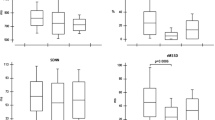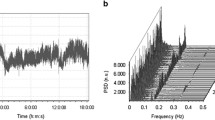Abstract
Autonomic dysreflexia (AD) is a life-threatening condition for individuals with cervical or high-thoracic spinal cord injury (SCI). The profile of autonomic dysfunction in AD using validated clinical autonomic tests has not been described so far, although it could be useful to identify SCI patients at greater risk of developing AD non-invasively. With this objective, 37 SCI patients (27% female) were recruited, and hemodynamic and cardiac parameters were continuously monitored to determine the presence of AD, defined as an increase of systolic blood pressure of 20 mmHg or higher after bladder filling with saline. Then, standard autonomic function testing was performed, including Deep Breathing, Valsalva Manoeuvre and Tilt Table Test. Finally, baroreflex sensitivity (BRS), and spectral analysis of heart rate and blood pressure variability were measured at rest. Catecholamines and vasopressin levels were also measured at supine and upright positions. The severity of SCI was assessed through clinical and radiological examinations. AD was observed in 73.3% of SCI patients, being 63.6% of them asymptomatic during the dysreflexive episode. AD patients displayed a drop in sympathetic outflow, as determined by decreased noradrenalin plasma levels, reduced sympathovagal balance and increased BRS. In line with decreased sympathetic activity, the incidence of neurogenic orthostatic hypotension was higher in AD patients. Our results provide novel evidence regarding the autonomic dysfunction in SCI patients with AD compared to non-AD patients, posing non-invasively measured autonomic parameters as a powerful clinical tool to predict AD in SCI patients.


Similar content being viewed by others
Availability of data and material
Data are available upon reasonable request.
References
Salim MS, Mazlan M, Hasnan N (2017) Intracerebral haemorrhage following uncontrolled autonomic dysreflexia post suprapubic catheter placement surgery. Spinal Cord Ser Cases 3:17043
West CR, Squair JW, McCracken L, Currie KD, Somvanshi R, Yuen V, Phillips AA, Kumar U, McNeill JH, Krassioukov AV (2016) Cardiac consequences of autonomic dysreflexia in spinal cord injury. Hypertension 68:1281–1289
Hubbard ME, Phillips AA, Charbonneau R, Squair JW, Parr AM, Krassioukov A (2019) PRES secondary to autonomic dysreflexia: a case series and review of the literature. J Spinal Cord Med 1–7
Vírseda-Chamorro M, Salinas-Casado J, Gutiérrez-Martín P, de la Marta-García M, López-García-Moreno A, Esteban Fuertes M (2017) Risk factors to develop autonomic dysreflexia during urodynamic examinations in patients with spinal cord injury. Neurourol Urodyn 36:171–175
Weaver LC, Fleming JC, Mathias CJ, Krassioukov AV (2012) Disordered cardiovascular control after spinal cord injury. Handb Clin Neurol 109:213–233
Frankel HL, Mathias CJ (1979) Cardiovascular aspects of autonomic dysreflexia since Guttmann and Whitteridge (1947). Spinal Cord 17:46–51
Shouman K, Benarroch EE (2019) Segmental spinal sympathetic machinery: implications for autonomic dysreflexia. Neurology 93:339–345
Lindan R, Joiner E, Freehafer AA, Hazel C (1980) Incidence and clinical features of autonomic dysreflexia in patients with spinal cord injury. Paraplegia 18:285–292
Liu N, Zhou M, Biering-Sørensen F, Krassioukov AV (2015) Iatrogenic urological triggers of autonomic dysreflexia: a systematic review. Spinal Cord 53:500–509
Walter M, Knüpfer SC, Cragg JJ, Leitner L, Schneider MP, Mehnert U, Krassioukov AV, Schubert M, Curt A, Kessler TM (2018) Prediction of autonomic dysreflexia during urodynamics: a prospective cohort study. BMC Med 16:53
Koyuncu E, Ersoz M (2017) Monitoring development of autonomic dysreflexia during urodynamic investigation in patients with spinal cord injury. J Spinal Cord Med 40:170–174
Roberts TT, Leonard GR, Cepela DJ (2017) Classifications in brief: American Spinal Injury Association (ASIA) Impairment Scale. Clin Orthop Relat Res 475:1499–1504
Sharif H, Hou S (2017) Autonomic dysreflexia: a cardiovascular disorder following spinal cord injury. Neural Regener Res 12:1390–1400
Cragg JJ, Noonan VK, Krassioukov A, Borisoff J (2013) Cardiovascular disease and spinal cord injury: results from a national population health survey. Neurology 81:723–728
Wu JC, Chen YC, Liu L, Chen TJ, Huang WC, Cheng H, Tung-Ping S (2012) Increased risk of stroke after spinal cord injury: a nationwide 4-year follow-up cohort study. Neurology 78:1051–1057
Krassioukov A, Alexander MS, Karlsson AK, Donovan W, Mathias CJ, Biering-Sørensen F (2010) International spinal cord injury cardiovascular function basic data set. Spinal Cord 48:586–590
Freeman R, Wieling W, Axelrod FB, Benditt DG, Benarroch E, Biaggioni I, Cheshire WP, Chelimsky T, Cortelli P, Gibbons CH, Goldstein DS, Hainsworth R, Hilz MJ, Jacob G, Kaufmann H, Jordan J, Lipsitz LA, Levine BD, Low PA, Mathias C, Raj SR, Robertson D, Sandroni P, Schatz I, Schondorff R, Stewart JM, van Dijk JG (2011) Consensus statement on the definition of orthostatic hypotension, neurally mediated syncope and the postural tachycardia syndrome. Clin Auton Res 21:69–72
Lee ES, Joo MC (2017) Prevalence of autonomic dysreflexia in patients with spinal cord injury above T6. Biomed Res Int 2017:2027594
Huang YH, Bih LI, Liao JM, Chen SL, Chou LW, Lin PH (2013) Blood pressure and age associated with silent autonomic dysreflexia during urodynamic examinations in patients with spinal cord injury. Spinal Cord 51:401–405
Wan D, Krassioukov AV (2014) Life-threatening outcomes associated with autonomic dysreflexia: a clinical review. J Spinal Cord Med 37:2–10
Zhang Y, Guan Z, Reader B, Shawler T, Mandrekar-Colucci S, Huang K, Weil Z, Bratasz A, Wells J, Powell ND, Sheridan JF, Whitacre CC, Rabchevsky AG, Nash MS, Popovich PG (2013) Autonomic dysreflexia causes chronic immune suppression after spinal cord injury. J Neurosci 33:12970–12981
West CR, Bellantoni A, Krassioukov AV (2013) Cardiovascular function in individuals with incomplete spinal cord injury: a systematic review. Top Spinal Cord Injury Rehabil 19:267–278
Berger MJ, Kimpinski K, Currie KD, Nouraei H, Sadeghi M, Krassioukov AV (2017) Multi-domain assessment of autonomic function in spinal cord injury using a modified autonomic reflex screen. J Neurotrauma 34:2624–2633
Brown R, DiMarco AF, Hoit JD, Garshick E (2006) Respiratory dysfunction and management in spinal cord injury. Respir Care 51:853–868 (discussion 869–870)
Gao SA, Ambring A, Lambert G, Karlsson AK (2002) Autonomic control of the heart and renal vascular bed during autonomic dysreflexia in high spinal cord injury. Clin Auton Res 12:457–464
Krum H, Brown DJ, Rowe PR, Louis WJ, Howes LG (1990) Steady state plasma [3H]-noradrenaline kinetics in quadriplegic chronic spinal cord injury patients. J Auton Pharmacol 10:221–226
McLachlan EM (2007) Diversity of sympathetic vasoconstrictor pathways and their plasticity after spinal cord injury. Clin Auton Res 17:6–12
Al Dera H, Brock JA (2018) Changes in sympathetic neurovascular function following spinal cord injury. Auton Neurosci Basic Clin 209:25–36
Lee JS, Fang SY, Roan JN, Jou IM, Lam CF (2016) Spinal cord injury enhances arterial expression and reactivity of α1-adrenergic receptors-mechanistic investigation into autonomic dysreflexia. Spine J 16:65–71
Grimm DR, Almenoff PL, Bauman WA, De Meersman RE (1998) Baroreceptor sensitivity response to phase IV of the Valsalva maneuver in spinal cord injury. Clin Auton Res 8:111–118
Stampas A, Zhu L, Li S (2019) Heart rate variability in spinal cord injury: asymptomatic orthostatic hypotension is a confounding variable. Neurosci Lett 703:213–218
Goh MY, Wong EC, Millard MS, Brown DJ, O’Callaghan CJ (2015) A retrospective review of the ambulatory blood pressure patterns and diurnal urine production in subgroups of spinal cord injured patients. Spinal Cord 53:49–53
Roozbehi A, Joghataei MT, Bakhtiyari M, Mohammadi J, Rad P, Delaviz H (2015) Age-associated changes on axonal regeneration and functional outcome after spinal cord injury in rats. Acta Med Iran 53:281–286
Mironets E, Osei-Owusu P, Bracchi-Ricard V, Fischer R, Owens EA, Ricard J, Wu D, Saltos T, Collyer E, Hou S, Bethea JR, Tom VJ (2018) Soluble TNFα signaling within the spinal cord contributes to the development of autonomic dysreflexia and ensuing vascular and immune dysfunction after spinal cord injury. J Neurosci 38:4146–4162
Hasegawa Y, Sawada M, Ozaki N, Inagaki T, Suzumura A (2000) Increased soluble tumor necrosis factor receptor levels in the serum of elderly people. Gerontology 46:185–188
Ebert TJ, Cowley AW Jr, Skelton M (1986) Vasopressin reduces cardiac function and augments cardiopulmonary baroreflex resistance increases in man. J Clin Investig 77:1136–1142
Funding
No authors have received any funding from any institution, including personal relationships, interests, grants, employment, affiliations, patents, inventions, honoraria, consultancies, royalties, stock options/ownership, or expert testimony for the last 12 months.
Author information
Authors and Affiliations
Corresponding author
Ethics declarations
Conflicts of interest
None of the authors have any conflicts of interest or financial ties to disclose.
Ethical approval
The study was approved by the local ethics committee (Basque Ethics Committee, Reference PI2013132) and patients gave written informed consent before inclusion in the study, in accordance with the tenets of the Declaration of Helsinki.
Rights and permissions
About this article
Cite this article
Cívicos Sánchez, N., Acera, M., Murueta-Goyena, A. et al. Quantitative analysis of dysautonomia in patients with autonomic dysreflexia. J Neurol 268, 2985–2994 (2021). https://doi.org/10.1007/s00415-021-10478-w
Received:
Revised:
Accepted:
Published:
Issue Date:
DOI: https://doi.org/10.1007/s00415-021-10478-w




